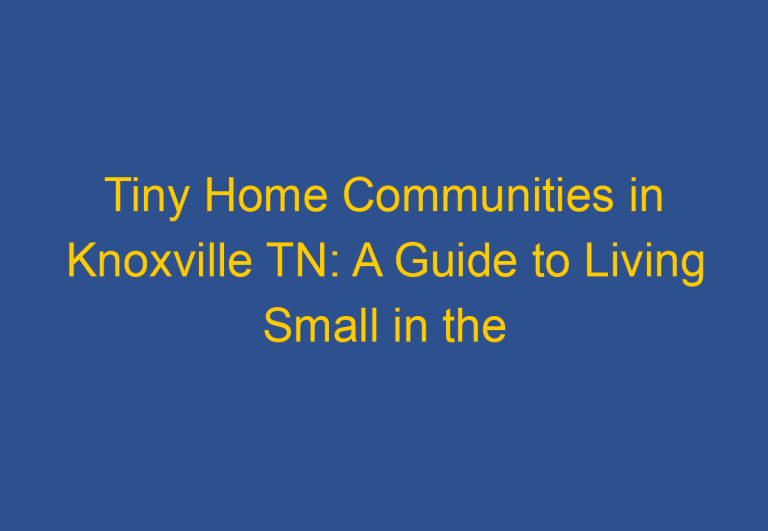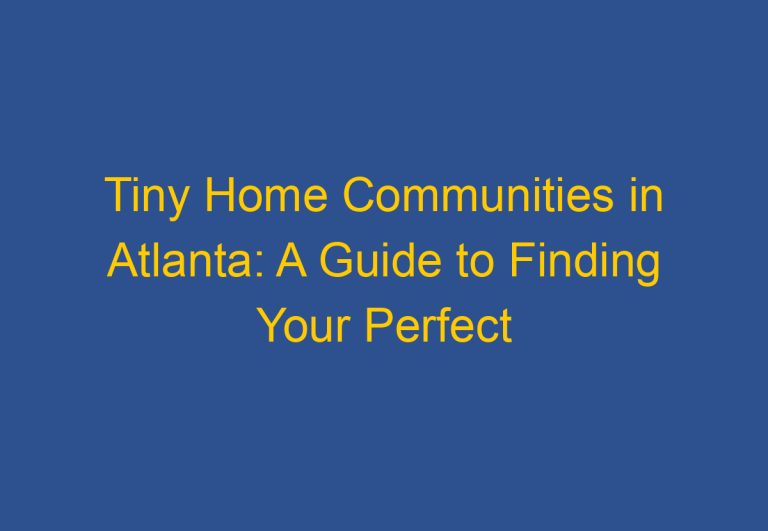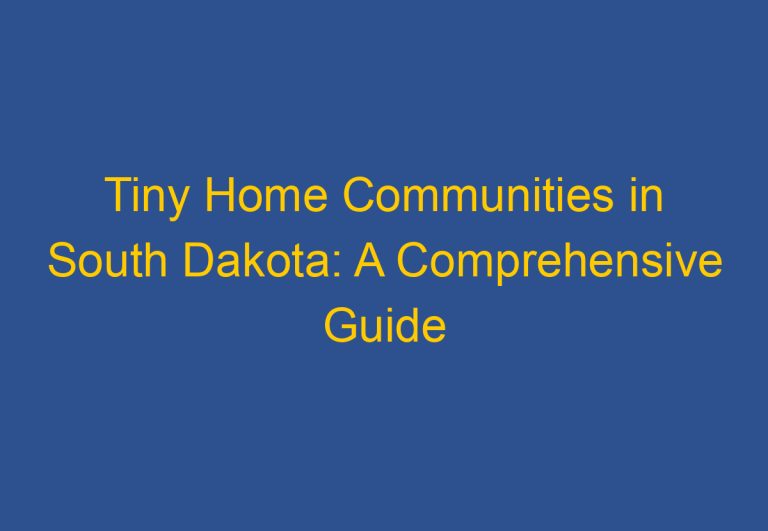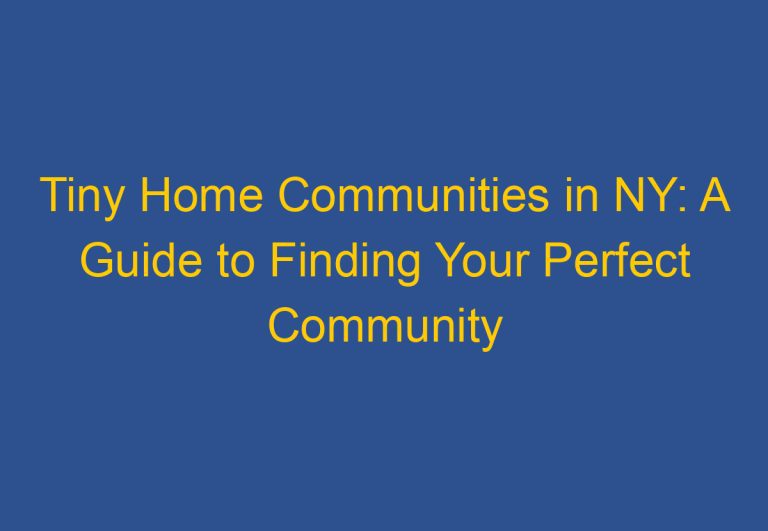Tiny Home Communities in Connecticut: A Guide to Sustainable Living
Connecticut is a state known for its beautiful landscapes, rich history, and charming towns. In recent years, it has also become a hub for the tiny house movement, with several tiny home communities popping up across the state. These communities offer a unique opportunity for individuals to live a more sustainable lifestyle, while also enjoying the benefits of community living.
Tiny home communities in Connecticut are designed to provide residents with a simpler, more affordable way of life. These communities typically consist of small, eco-friendly homes that are built using sustainable materials and energy-efficient technologies. They also offer a range of communal amenities, such as shared outdoor spaces, community gardens, and recreational facilities. These amenities foster a sense of community among residents, who often share similar values and interests.
Living in a tiny home community in Connecticut can be a transformative experience. It allows individuals to downsize their possessions and live a more minimalist lifestyle, while also connecting with like-minded individuals and contributing to a sustainable way of life. As the tiny house movement continues to grow in popularity, it is likely that we will see more of these communities popping up across the state.
Understanding Tiny Home Communities in Connecticut
Legal Landscape and Zoning Laws
In Connecticut, tiny homes are subject to all applicable state and municipal rules and the International Residential Code (IRC), although no particular state legislation governs them. Therefore, it is important to check with local zoning laws before building or buying a tiny home. In addition, it is worth noting that tiny homes can be built on wheels, which can be classified as recreational vehicles (RVs) or mobile homes, depending on the size and design.
Benefits of Tiny Living
Tiny homes offer several benefits, including a smaller environmental footprint, lower costs, and a simpler lifestyle. They are also a great option for those who want to downsize or live more sustainably. Tiny home communities in Connecticut provide a unique opportunity for like-minded individuals to come together and live in a supportive and sustainable environment.
Tiny home communities typically offer a variety of amenities, including shared spaces such as community gardens, laundry facilities, and common areas. They also often feature events and activities that foster a sense of community and encourage residents to get to know one another. Additionally, many tiny home communities are designed with sustainability in mind, incorporating features such as solar panels, rainwater harvesting systems, and composting toilets.
In conclusion, tiny home communities in Connecticut offer a unique and sustainable living option for those who value minimalism and community. However, it is important to be aware of the legal landscape and zoning laws before embarking on a tiny home journey.
Building and Living in Tiny Houses
Design and Construction
Building a tiny house requires careful planning and design. The design should take into account the available space and the intended use of the tiny house. The construction of a tiny house can be done using a variety of materials such as wood, steel, and concrete. One of the most important factors to consider when building a tiny house is energy efficiency. Insulation is crucial in keeping the tiny house warm during the winter and cool during the summer.
A loft is an essential feature of a tiny house as it maximizes the living space. The loft can be used as a bedroom or a storage space. The kitchen and bathroom should be designed to maximize space and efficiency. The kitchen should have a small refrigerator, a stove, and a sink. The bathroom should have a toilet, a shower, and a sink.
Maximizing Space and Efficiency
Living in a tiny house requires a minimalist lifestyle. The limited space means that one has to get creative in maximizing space and efficiency. One way to do this is by using multi-functional furniture. For example, a sofa can be converted into a bed, and a table can be used as a desk.
The use of vertical space is also crucial in maximizing space. Shelves can be mounted on the walls to create additional storage space. The use of light colors in the interior design can make the tiny house feel more spacious.
Living in a tiny house comes with its own set of challenges. One of the most significant challenges is the limited space. One has to be disciplined and organized to keep the tiny house clutter-free. Another challenge is the lack of privacy. The close proximity of living spaces means that one has to be mindful of noise levels.
In conclusion, building and living in a tiny house requires careful planning, design, and organization. It can be a rewarding experience for those who value a minimalist lifestyle and want to reduce their carbon footprint.
Locations and Lifestyle
Popular Tiny House Locations
Connecticut has a range of tiny home communities that offer plenty of amenities and great living experiences. Some popular locations include Hartford, New Haven, Middletown, and Mystic. These areas offer a mix of urban and rural environments, so residents can choose the lifestyle that suits them best.
For those who prefer a more secluded lifestyle, there are tiny home communities in the woods and other rural areas. These communities offer a chance to downsize and live a simpler, more sustainable lifestyle.
Community Amenities and Lifestyle
Tiny home communities in Connecticut provide a unique way to downsize and live with purpose. From waterfront properties in Mystic to modern homes in the heart of the city, there are plenty of options to choose from.
Community amenities vary, but most offer shared spaces such as community gardens, recreation areas, and laundry facilities. Some communities also offer on-site management and maintenance services.
Residents of tiny home communities in Connecticut often share a similar lifestyle philosophy. They value sustainability, minimalism, and community living. Many residents are drawn to the sense of community and shared values that come with living in a tiny home community.
Overall, tiny home communities in Connecticut offer a unique opportunity to downsize and live a more sustainable lifestyle. With a range of locations and amenities to choose from, residents can find the perfect community to fit their needs.
Acquiring a Tiny Home
Buying vs. Renting
When it comes to acquiring a tiny home, one must first decide whether to buy or rent. Buying a tiny home gives the owner more freedom and control over the property, but it requires a significant upfront investment. On the other hand, renting a tiny home is a more affordable option for those on a limited budget, but it may come with certain restrictions and limitations.
Craft & Sprout is a tiny house builder in Connecticut that offers both buying and renting options. They provide custom-built tiny homes that are designed to meet the specific needs and preferences of their clients. For those who are interested in renting, they offer a variety of rental options that cater to different budgets and lifestyles.
Tiny House Builders and Vendors
If you decide to buy a tiny home, there are several builders and vendors in Connecticut that specialize in tiny homes. These include:
-
Tiny House Northeast: This company offers custom-built tiny homes on wheels that are designed to be mobile and energy-efficient.
-
B&B Micro Manufacturing: This company specializes in building tiny homes that are affordable, customizable, and eco-friendly.
-
Connecticut Valley Homes: While not exclusively a tiny house builder, this company offers a variety of small and energy-efficient homes that could be suitable for those interested in the tiny house lifestyle.
It’s important to do your research and choose a builder or vendor that has a good reputation and a track record of delivering quality homes. Additionally, make sure to ask questions about the building process, materials used, and warranties offered to ensure that you are getting the best value for your investment.
Frequently Asked Questions
What are the best-rated tiny home communities in Connecticut?
Connecticut has a number of highly rated tiny home communities, each with its own unique charm and features. Some of the best-rated tiny home communities in Connecticut include the Tiny House Village, the Green Valley Sustainable Village, and the Rustic Tiny House Retreat. These communities offer a range of amenities, from community gardens and shared outdoor spaces to clubhouses and recreational facilities.
Are there any luxury tiny home communities in Connecticut?
Yes, there are luxury tiny home communities in Connecticut. These communities offer a range of high-end amenities and features, such as gourmet kitchens, spa-like bathrooms, and high-end finishes. Some of the most popular luxury tiny home communities in Connecticut include the Lake Tiny House Community and the Tiny Home Haven.
Can I find affordable tiny home communities in Connecticut?
Yes, there are affordable tiny home communities in Connecticut. These communities offer a range of affordable housing options for those looking to downsize and simplify their lives. Some of the most affordable tiny home communities in Connecticut include the DIY Tiny Homes and the Foundation-Based Tiny Homes.
What are the options for tiny home communities in Connecticut that offer homes for sale?
Connecticut has a number of tiny home communities that offer homes for sale. These communities offer a range of options, from pre-built homes to custom-built homes. Some of the most popular tiny home communities in Connecticut that offer homes for sale include the Tiny House Village and the Green Valley Sustainable Village.
Are there tiny home communities in Connecticut with rental availability?
Yes, there are tiny home communities in Connecticut that offer rental availability. These communities offer a range of rental options, from short-term rentals to long-term leases. Some of the most popular tiny home communities in Connecticut that offer rental availability include the Lake Tiny House Community and the Rustic Tiny House Retreat.
What are the legal requirements for living in a tiny home in Connecticut?
In Connecticut, tiny homes must meet the minimum standards set forth in the Connecticut State Building Code. This means that tiny homes must be built on a permanent foundation and must have a minimum of 150 square feet of living space. Additionally, local zoning regulations determine what types of structures are allowed in a given area, so it is important to check with local authorities before building or living in a tiny home in Connecticut.












